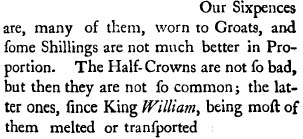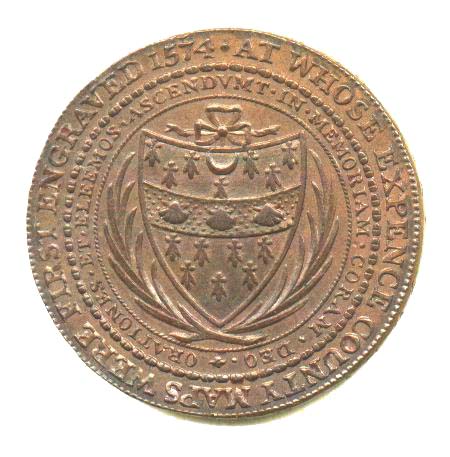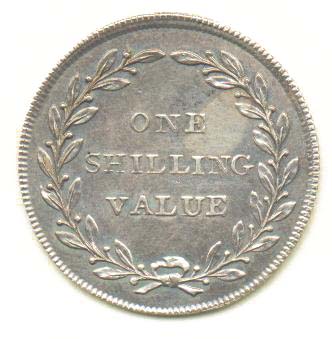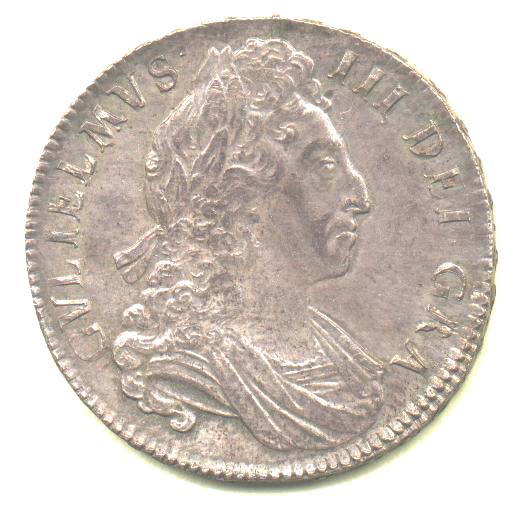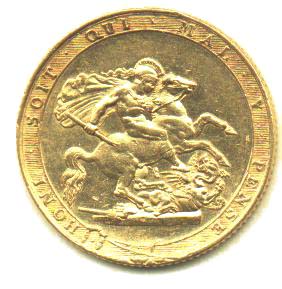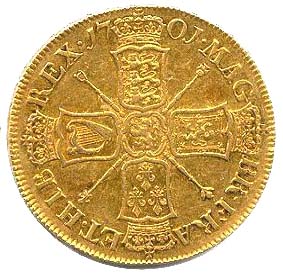Introduction
Steven Leake, 1745 39 |
In eighteenth century England, money was not decimalized as it is today. To barter and trade effectively, one had to possess a solid knowledge of the relative values of coins as well as local currency. Shown below is a chart of the denominations and relative worth of coins in eighteenth century England, which should prove useful in navigating various other components of this site. Also available below is the eighteenth century calculator, which will convert today's American dollars into 1750 British pounds and vice versa.
The pound sterling (£) was the basic currency unit of England during the eighteenth century. In 1717, Sir Isaac Newton, Master of the Royal Mint (see picture on the right) , switched to the gold standard. Historically, since 1158, silver had been the standard.41 The 1700's presented England with unique challenges that caused major changes in the monetary system. This page specifically outlines the severe coin shortage and Britain's challenge in redefining their monetary system in the presence of increasing international trade.

Sir Isaac Newton
Master of the Royal Mint40
Money Calculators
Interested in discovering the eighteenth century worth of money? Click on one of the links below to open the eighteenth century calculator!
Convert my present day American dollars to 1750 English pounds!
Convert 1750 pounds to current American dollars!
A Note on Nomenclature
The British monetary system stems from Roman tradition. Shown below are the abbreviations and root names for the major English denominations:
- The symbol £ comes from the Latin name for pound “libra.”
- The abbreviation for penny (d) comes from the Roman “denarius”
- The abbreviation for shilling (s) comes from the Roman “solidus”
Eighteenth century English vernacular included several slang terms that may be unfamilar to today's reader:
- "bob"was slang for a shilling
- "quid"was slang for a pound
The oft used plural for penny in England was "pence."42
The table to the left shows the root of English denominations. Note that several of the early Saxon coins have the same names as their 18th century British counterparts.
English Denominations Stemmed from Roman and Saxon Tradition: A Table of Saxon Coins and Values Circa 8th Century43

Relative Worth of Eighteenth Century British Denominations44
2 farthings
|
1 halfpenny
|
| 4 farthings
|
1 penny (d)
|
12 pennies
|
1 shilling (s)
|
5 shillings (s)
|
1 crown
|
4 crowns
|
1 pound sterling (£) (sovereign)
|
| 21 shillings (s)
|
1 guinea
|
In the eighteenth century, the supply of money was far from sufficient for the growing English economy. The shortage of coins available for daily activities, such as paying wages and purchasing common goods resulted in discordance and inconvenience. The shortage of coins in circulation was due mainly to the woes of the Royal Mint. The specialists (Assayers, Melters, Refiners, Engravers and Medallists) of the Royal Mint were allowed to carry out contract work in addition to his public duty. The individual moneyer was guaranteed a small fixed annual payment from the government, but the bulk of his income came primarily from commission on private contracts. Thus, private accounts often took precedence over orders from the Treasury. Also contributing to the shortage of coins was the shrinking number of moneyers. The astronomical cost of apprenticeship restricted membership to the company, contributing to the coin shortage problem. 45
The High Cost of Apprenticeship Contributes to a Decrease of Moneyers at the Royal Mint46
| Year | Number of Moneyers |
| 1650 | 59 |
| 1705 | 16 |
| 1774 | 8 |
Differing International Gold Standards Contributes to Efflux of British Silver47
| Country | Pounds of Silver | Pounds of Gold |
| England | 15.5 | 1 |
| Spain | 16 | 1 |
| India | 12 | 1 |
| Japan | 9 | 1 |
International Trade Contributes to Coin Crisis
If the woes of the
Royal Mint were insufficient to cause a devastating shortage of silver
coin in Britain, the growing international trade certainly assured this
outcome. In England, the standard of money had always been based on silver.
However, with the introduction and subsequent widespread use of the Spanish
guinea in the late seventeenth century, England was forced to assign a
value to the gold coin. The chart to the left shows the worth of silver
relative to gold in the early years of the eighteenth century. The Spanish
took advantage of the conversion to import silver bullion and exchange
it for gold. Under English law, precious metals could be exported in the
form of bullion or foreign coin, but not in coins of the realm. However,
the opportunity remained irresistible, and many “money jobbers”
and “exchange dealers” melted the heaviest silver coins available
to export to India and Japan. In 1712, Sir Isaac Newton declared, “gold
in England is overvalued in proportion to silver … and this excess
value tends to increase the gold coins and diminish the silver coins of
this kingdom.” However, Newton’s proposed remedies were ignored
until 1717, when the guinea was revalued from 21s 6d to 21s. Still the
measure did little to stifle the drain of English silver to foreign countries.
It was a practice that was neither curtailed nor compensated for in the
eighteenth century.48
By
the 1720’s, private coining of copper in Ireland was widespread.
In the following decades the practice spread and grew in England. By 1792,
the country was flooded with these tokens.49
During the mid-1700’s, a shortage of official coins prompted
local provinces to issue their own half-pennies and farthings. The result
was a multitude of coins in circulation, with varying designs, face values
and intrinsic values. These tokens served multiple uses beyond relieving
the small change shortage:
• Propagandists used them to promote various political causes.
• Issuers used them for advertising, hence the occasional lack of
value on the face coin.
• Many people became interested in collecting coins, in perhaps
the first documented instance of this phenomenon.50
The designs were multiple and varied as in the examples on the left, from
Norfolk and the Political Series. The fact that many of these tokens were
never turned in for redemption indicates that they served a real purpose
in relieving the coin shortage.51
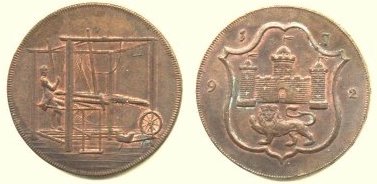
Norwich Half Penny Coin 179252
Obverse: Weaver working at a loom
Reverse: Norwich shield of arms
Issued by John Harvey of Norwich
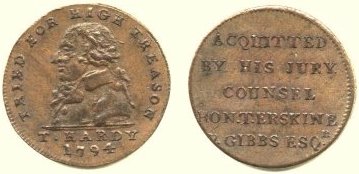
Political Series Token 179453
(no printed value)
Obverse:
Thomas Hardy (tried for treason)
Reverse: "Acquitted by his Jury"
